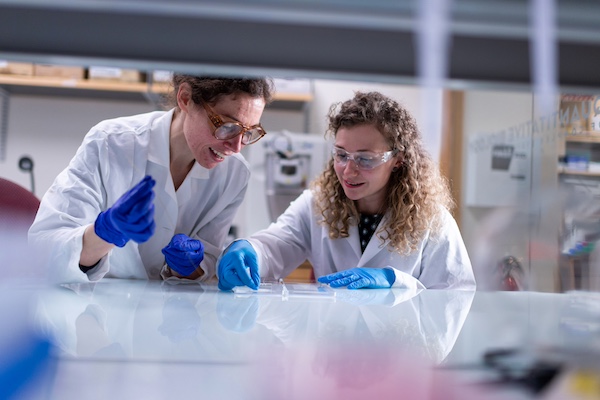Breaking through the noise of molecular imaging data with advanced computational tools
Raison Dsouza’s parents hired tutors to help him take the exams needed to gain entry to engineering or medical schools in his native India. But the 15-year-old had a different goal.
Intent on becoming a physicist, he ditched his prep school studies, hung around cyber cafes and played pick-up basketball.

“I didn’t do well on the engineering and med school exams, and I had no option but to do a bachelor’s in science,” says Dsouza, who today is an assistant scientist in Morgridge’s John W. and Jeanne M. Rowe Center for Research in Virology. “And my parents were fine with it. They supported me no matter what.”
Dsouza’s interest in physics bloomed after a teacher gave him a copy of Stephen Hawking’s “A Brief History of Time” a couple of years earlier.
“I wanted to learn how stars work; how black holes work. There’s something in the universe that’s attracting things to it, but you can’t see it. Especially for a teenager, that’s amazing,” he says.
As an undergraduate, he was an insatiable reader, even winning a prize at St. Aloysius Degree College in Mangalore, India for borrowing the most books from the library in a year. From there, he earned a master’s degree in physics from the National Institute of Technology Karnataka.
With a hunger for learning abroad and proceeds from an earlier undergraduate scholarship in his pocket, Dsouza was attracted by Germany’s Max Planck Institute for the Structure and Dynamics of Matter for his doctoral studies.
In the midst of his work as a research fellow studying the superconducting properties of graphene, Dsouza’s mentor left the institute and Dsouza’s appointment was in jeopardy. But through luck and resourcefulness, Dsouza managed his way through the crisis.
“Luckily enough, in Germany you have the beer-garden culture, where people go out and have a beer in the afternoon in the summer,” he says. “Another researcher said, ‘You do simulations. You’re a computer guy. We have a problem we need to fix.’”
He first agreed to work with lasers and tissue ablation, then moved to another project in the same lab as a theoretical physicist looking at the behavior of proteins’ role in photosynthesis. “It turned out to be a good thing because while I couldn’t get a unifying theme in my Ph.D. thesis, I was able to tackle three or four problems, which my boss and I thought was a win,” Dsouza says.
He spent his postdoctoral fellowship at UW–Milwaukee using machine learning to analyze and improve images obtained through electron microscopy. Along the way, Dsouza met a postdoc working with Morgridge Investigator Timothy Grant, who encouraged Dsouza to join the institute.
“Science is not just to solve a problem, but to understand what the problem is. And then once you find the solution, how does that work?”
Raison Dsouza
In the Grant Lab, Dsouza is developing new computational methods to analyze cryo-electron microscopy images, trying to find specific particles in “noisy,” corrupted data.
“It’s like playing ‘Where’s Waldo,’ because you have all of these proteins interacting with each other and we need to locate a protein of interest inside of cells,” Dsouza says. “We do that through template matching, which is something like facial recognition of proteins.”
Although artificial intelligence can be analytic tool, Dsouza shies away from its exclusive use.
“AI is a black box. Yeah, it works, but how do you know that it works?” he asks. “Science is not just to solve a problem, but to understand what the problem is. And then once you find the solution, how does that work?”
He also develops software that leverages virtual reality to visualize molecular data and thrives in Morgridge’s interdisciplinary culture.
“You’re making coffee and you run into another researcher working with flatworms, and they invite you to their lab to see their work and you trade information about papers you’ve read. There are a lot of sections of biology working together,” he says. “There are so many good things going on here. This is a very special place.”

Rising Sparks: Early Career Stars
Rising Sparks is a monthly profile series exploring the personal inspirations and professional goals of early-career scientists at the Morgridge Institute.

